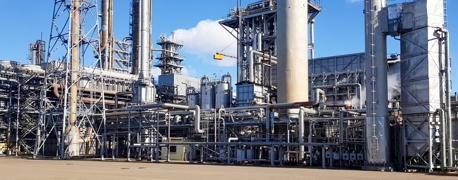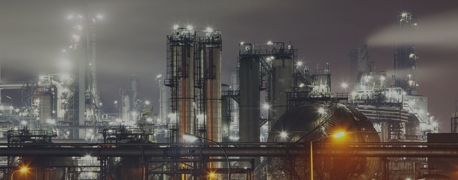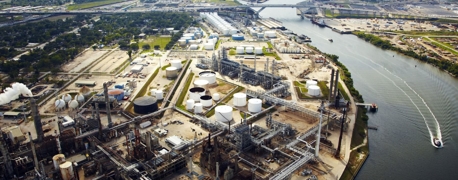10 Most Dangerous Chemical Plants to Work At

Chemical refineries and plants are filled with volatile chemicals and byproducts traveling through hundreds of miles of pipes and tanks at high pressures. Even water (when heated into steam) is a hazard in the typical chemical plant. Plants are the sort of place where cutting corners gets people hurt or killed. The latest figures from the Bureau of Labor Statistics show that 300 people were injured at petroleum refineries in 2020 alone.
That’s why it’s vital to know what kind of plant management you’ll be working with. Is your company the kind that runs a safe workplace? Or do they have a higher-than-average number of fatalities at their facilities? For some workers, the answer is surprising. Many don't know how their employers will react until after an explosion or other catastrophe has occurred and they are left facing uncertain futures.
Before we dive in, let's take a look at the explosion that placed BP #1 on our list.
How Common Are Hazardous Chemical Incidents?
According to a report by the nonprofit Coming Clean, between January 1, 2021, and October 15, 2023, there were more than 825 hazardous chemical incidents. These incidents resulted in at least 43 deaths, as well as over 150 hospitalizations, injuries, and accounts of related acute symptoms.
The report also found that:
- Texas far outpaced all other states when it came to hazardous chemical incidents. During the aforementioned timeframe, Texas was home to at least 79 incidents.
- California and Louisiana were also among the top three most dangerous states for hazardous chemical incidents with 46 and 39 incidents, respectively.
- Most (344) of the hazardous chemical incidents occurred within the plastics and petrochemical manufacturing sector, followed by oil and gas (96).
- More than 50 incidents, including chemical-related fires, explosions, and leaks, involved distribution, storage, and/or transportation.
- More than 200 of the chemical incidents included in the report were caused by or worsened by weather events, such as hurricanes and tornadoes.
Notable facilities named in the report include:
- Marathon Petroleum: On August 25, 2023, a fire broke out at the Marathon Petroleum refinery in Garyville, Louisiana. The fire was later connected to a naphtha leak that had begun 15 hours earlier, at around 6:30 p.m. on August 24. Though nearby residents were never given an evacuation order, many reported experiencing eye irritation and respiratory problems consistent with volatile organic compounds (VOCs), which are present in naphtha. The 2023 fire came just a year and a half after a massive explosion at the same plant sent at least six workers to the hospital.
- Honeywell: In October 2021, a worker at a Honeywell plant in Geismar, Louisiana, died after being exposed to hydrofluoric acid, a highly corrosive and toxic substance and one of the main chemicals produced at the plant. In July 2022, workers at Honeywell’s Carville blowing agent factory were ordered to shelter in place with at least one employee receiving treatment due to a hydrogen fluoride leak, and an explosion on January 23, 2023, resulted in both hydrogen fluoride and chlorine being released. According to the Advocate, the plant was home to 11 leaks involving flammable and/or toxic chemicals in just three years.
- Vantage Chemicals: At least one worker was injured when a fire broke out at the Vantage Chemicals plant in Gurnee, Illinois, on September 19, 2021. The facility reportedly uses ethylene oxide, a known carcinogen, in the production of various products, including emulsifiers, rust inhibitors, wetting agents, surfactants, lubricants, and more.
Notably, these facilities were all being regulated by the U.S. Environmental Protection Agency’s Risk Management Program (RMP). The program, which was established to help prevent hazardous chemical incidents, placed regulations on approximately 12,000 U.S. plants and refineries that use and/or store certain chemicals in specific quantities. According to the report by Coming Clean, there have been more than 175 hazardous chemical incidents at RMP regulated facilities since 2021.
The Most Dangerous Companies in the Chemical Industry
Because injury statistics per refinery are not public information, the following list was ranked according to total fatalities from 1995–2015 across all plants for each company.
#10: Citgo Petroleum – 3 Fatalities
With three fatalities at their Corpus Christi facility, Citgo Petroleum is the tenth most dangerous oil company on our list. The company was founded in 1912 in Oklahoma and today generates $24 billion in revenue.
Fatalities by individual facility:
- Corpus Christi, TX: 3
#9: Chevron Texaco – 3 Fatalities
Chevron Texaco has one of the longest histories of any oil company on the planet. Founded in 1879 as Pacific Coast Oil Co., it has survived for nearly 150 years and grown to an annual revenue of $162 billion. It sits at ninth on this list (technically tied for ninth) with three fatalities at a single facility.
Fatalities by individual facility:
- Pascagoula, MS: 3
#8: LyondellBasell – 5 fatalities
Founded in 2007, LyondellBasell is one of the youngest companies on this list. However, that means its public profile is more notable for having so many incidents in the news. Last year, a chemical leak at their La Porte facility killed 2 workers and hospitalized 30 more—a number not reflected in the figures below, since it occurred after 2015.
Fatalities by individual facility:
- Houston, TX: 5
#7: ConocoPhillips – 6 Fatalities
Founded in 2002, ConocoPhillips is based in Houston, but it operates in 15 countries on 5 continents. It has a revenue of $45 billion, earning it a place on the Fortune 500. Despite its founding in 2002, historically ConocoPhillips contains companies as old as 147 years. Instead of numerous deaths at one facility, ConocoPhillips is notable for having at least one fatality across numerous facilities.
Fatalities by individual facility:
- Westlake, LA: 2
- Hartford, IL: 1
- Wilmington, CA: 1
- Ponca City, OK: 1
- Old Ocean, TX: 1
#6: Marathon Petroleum – 6 Fatalities
Once a subsidiary of Marathon Oil, Marathon Petroleum became an independent company in 2011. Today, it’s the largest petroleum refinery operator in the country and ranks on the Fortune 100. Most of the company’s fatalities occurred at the Garyville facility in Louisiana, which alone would rank at #9 on this list.
Fatalities by individual facility:
- Garyville, LA: 4
- St Paul Park, MN: 1
- Robinson, IL: 1
#5: Motiva Enterprises – 8 Fatalities
Once owned by Shell under the name Star Enterprises, Motiva is now fully owned by Saudi Aramco. It’s headquartered in Houston and operates a facility in Port Arthur that is the largest refinery in North America. That same facility has enough fatalities to rank on this list by itself.
Fatalities by individual facility:
- Port Arthur, TX: 3
- Norco, LA: 2
- Delaware City, DE: 2
- Convent, LA: 1
#4: Tesoro – 8 Fatalities
Tesoro is the only company on this list no longer operating as an independent company, as it was acquired by Marathon Petroleum in 2018. However, when it was an independent refinery operator, it ranked on the Fortune 100 and Fortune Global 500. It was also known as the 24th biggest polluter in the country. The 8 fatalities on its record is, astoundingly, from a single facility; 7 of those deaths were from an explosion in 2010.
Fatalities by individual facility:
- Anacortes, WA: 8
#3: ExxonMobil – 9 Fatalities
Undoubtedly one of the most famous oil companies in the world, ExxonMobil is descended from Standard Oil—the company founded by the world-famous John D. Rockefeller. It was once the third-largest revenue producer in the world and consistently ranks in the top 10 of the Fortune 500.
It ranks high on our list as well, although for a less celebrated reason.
Fatalities by individual facility:
- Torrance, CA: 4
- Baytown, TX: 3
- Beaumont, TX: 2
#2: Valero Energy Corp. – 10 Fatalities
Valero remains one of the largest US fuel producers, but it was also one of the US’ largest retailers with nearly 7,000 retail outlets throughout the world. It has a revenue of over $118 billion and is based in San Antonio. Though none of its facilities has an egregious number of fatalities, it’s notable how many facilities it owns that have seen fatal incidents since 1995.
Fatalities by individual facility:
- Memphis, TN: 2
- Corpus Christi, TX: 2
- Texas City, TX: 2
- Ardmore, OK: 1
- Norco, LA: 1
- Delaware City, DE: 1
- Paulsboro, NJ: 1
#1: British Petroleum (BP) – 28 Fatalities
No, that number is not a typo—the number one most dangerous company on our list has more than 2x the fatalities of the second-place company, and nearly 10x the fatalities of the lowest-ranked companies. The vast majority of those fatalities come from the most infamous refinery accident in history: the BP Texas City refinery explosion. While not counted in this list, BP was also partially responsible for the Deepwater Horizon accident in 2010.
Our firm represented a number of workers who were harmed in that explosion, and we remain proud of our role in holding BP accountable for their egregious negligence.
Fatalities by individual facility:
- Texas City, TX: 22
- Cherry Point, WA: 2
- Whiting, IN: 2
- Carson, CA: 1
- Belle Chasse, LA: 1


